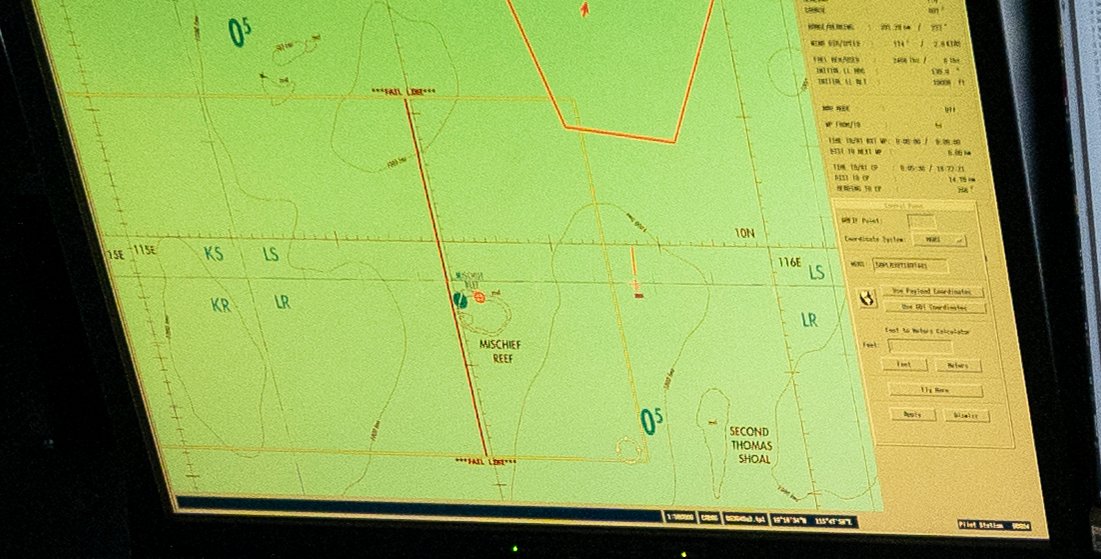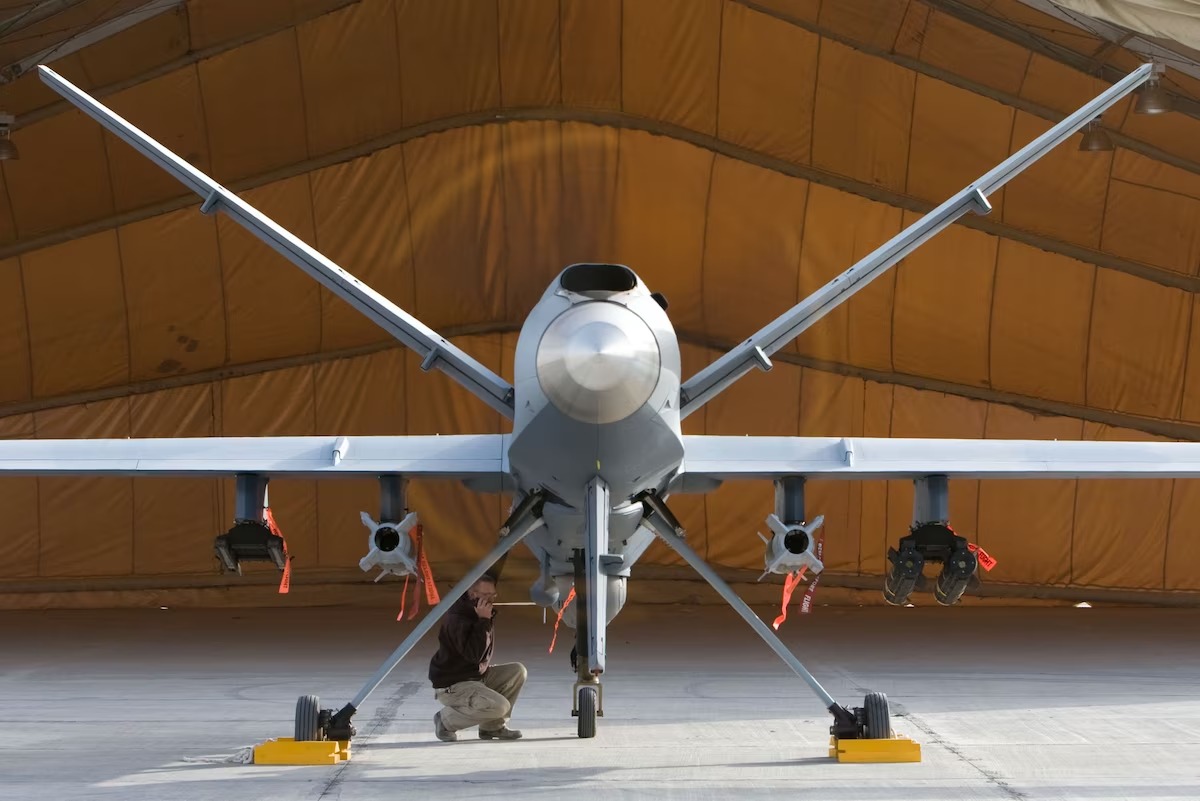The US Air Force’s (USAF) ‘ace’ drone, the MQ-9 Reaper, came forward for the fifth iteration of the ‘Reaper Smoke’ competition. This time, however, there was a catch: simulating an operation over an artificial island created by China in the volatile South China Sea.
At Hurlburt Field in Florida on September 5 and 6, 2024, over 30 MQ-9 Reaper squadrons from all across the Air Force gathered for the fifth annual Reaper Smoke competition.
While the convention might seem to be a regular one, images published of the exercise show an artificial Chinese island built over the Mischief Reef in the South China Sea as the focus for the Reaper combat drone event. Open-source intelligence (OSINT) researcher @IntelWalrus was the first to draw attention to the event on X (previously Twitter).
A closer examination of the published photos shows a computer display featuring a map that includes Mischief Reef, an atoll situated in the South China Sea to the east of the contested Spratly Islands. Mischief Reef is shown on several screens, possibly from a satellite image.
Though the Air Force has not said so directly, the map in the photographs appears to indicate that the reef may have been a simulated target in last week’s Reaper drone exercise.
AFSOC hosted an exercise for MQ-9 reaper pilots and operators at Hurlburt Field, featuring simulated missions & strikes over Mischief Reef in the Spratlys. 'Reaper Smoke 24' included "tactical scenarios aimed to test their abilities and decision-making" such as the one pictured. pic.twitter.com/24O8lU0cHs
— IntelWalrus (@IntelWalrus) September 12, 2024
Although located within the Philippines’ exclusive economic zone, China, Taiwan, and Vietnam claim the Mischief Reef.
Beijing has fortified the island and constructed military installations to establish territorial control over the region, much like several other features in the disputed sea, where it claims near-complete sovereignty in defiance of international norms.
Among its many characteristics, the Chinese military base at Mischief Reef has an airport, missile systems, and jamming technology.
Additionally, Mischief Reef is also located near the Second Thomas Shoal, another major area of contention that has witnessed heightened interactions between Filipino military forces and the Chinese Coast Guard (CCG).

As tensions run high between China and the Philippines, there is widespread concern that the aggressive engagements between the two sides could spiral into a conflict. If that happens, the US would be forced to enter the conflict against China due to its treaty obligations with Manila.
Drones are likely to act in a conflict in the Indo-Pacific, even if it is limited or low-intensity. This indicates that the Reaper simulation conducted over Mischief Reef is of greater importance than previously recognized.
How the Reapers were used, at this time, on the disputed atoll is currently unknown.
Defense Analyst and former submariner Tom Shugart commented: “Does the AFSOC really think they’re going to be able to operate MQ-9s over Mischief Reef??? I mean, maybe — but only after enough munitions-intensive softening up (likely conducted by others) that they’d mostly just be making the rubble bounce.”
The US conducts regular military activity in the region. For instance, USS Milius, a guided-missile destroyer, sailed within 12 nautical miles of Mischief Reef in April this year.
At that time, the US Navy said, “Features like Mischief Reef submerged at high tide in their naturally formed state are not entitled to a territorial sea. The land reclamation efforts, installations, and structures built on Mischief Reef do not change this characterization under international law.”

However, the simulation of MQ-9 Reapers over the region may be a completely different scenario, especially in a combat role. EurAsian Times reached out to Miguel Miranda, a Philippines-based military analyst, to understand if the US could deploy Reapers over China’s militarised island.
Miranda said, “Yes, the Philippine Air Force does that on its own… it’s not illegal. But drones over open seas in the Pacific are very risky. It looks cool in peacetime but a waste of time in an actual full-scale war.”
Miguel explained, “There’s an overreaction to the recent events in the annual Reaper Smoke exercises held earlier this month. I think it helps to remember the US Air Force has these exercises in Florida to enhance its drone operators’ skillset in multiple simulations. But there’s a clear urgency today as the entire US military pivot to familiarizing themselves with the Asia-Pacific region. However, drone surveillance anywhere in the South China Sea is hardly controversial. The Chinese are known to have flown long-endurance drones in the region for at least a decade now. The countries adjacent to the South China Sea have all sorts of surveillance drones at their disposal.”
The Filipino expert noted that the current generation of propeller-driven UAVs that perform intelligence/surveillance roles are just a single layer in more elaborate networks of regional-scale situational awareness.
“Their strongest advantage is having mission times from 15 to 20 hours at a stretch. So, their usefulness is beyond doubt. These UAVs in the low and medium altitude brackets aren’t invincible or invisible. There have been many instances these past few years where they have been lost over sensitive or high-risk water bodies like the Black Sea or the eastern Mediterranean coast. Even the Arabian Sea and the Persian Gulf.”

Reaper Smoke 2024
Reaper Smoke is an enterprise-wide tournament organized by the 2nd Special Operations Squadron that showcases the capabilities and innovations of the MQ-9 community. According to the update on the event published by DVIDS, it emphasizes innovation and operational readiness while upholding a deeply ingrained heritage.
Reaper Smoke is inspired by the Air Force’s renowned Gunsmoke competition, which began in 1949. The drill involves MQ-9 pilots and sensor operators from all across the Air Force participating in tactical situations that last 30 minutes and are meant to test their skills and judgment.
“This event isn’t just about tactics, training, or collaboration within the MQ-9 community; it’s about preserving our heritage and keeping the camaraderie strong,” Lt. Col. David Payne, 2nd SOS commander, said in an official statement. “It’s important we carry on this tradition, which dates back to the original Air Force Gunsmoke competition in 1949, by recognizing and crowning the top MQ-9 crews and continuing the rich heritage.”
Pilots and sensor operators participated in 30-minute tactical scenarios to evaluate their abilities and decision-making. These scenarios represented the changing face of modern warfare by presenting challenges ranging from general tactical maneuvers to specialized skills requiring precise and advanced techniques.
Staff Sgt. Francisco Rivera-Monge, 2nd SOS MQ-9 sensor operator and combat operations noncommissioned officer, emphasized the significance of including diverse commands in such events. “When it comes to the fight of tomorrow, we’re all going to be working together,” he said, and added, “Understanding each other’s capabilities is the key to success when it comes to MQ-9 survivability and the contribution in the fight for tomorrow.”
The competition would have offered valuable insights into the deployment strategies of Hurlburt Field’s 2nd Special Operations Squadron and the broader Air Force Special Operations Command (AFSOC) regarding the Reaper in upcoming contingencies, featuring in the presentations from leaders within the MQ-9 community. Perhaps this is where the focus on the South China Sea region comes into play.
- Contact the author at sakshi.tiwari9555 (at) gmail.com
- Follow EurAsian Times on Google News




